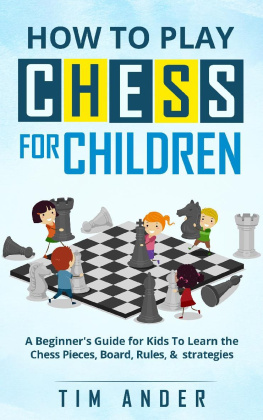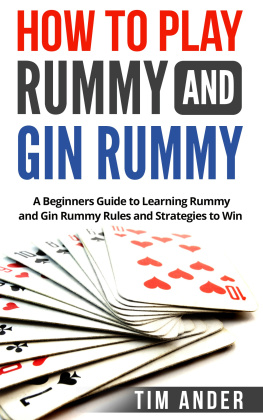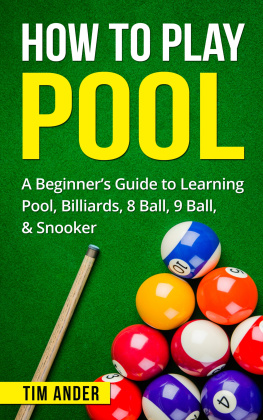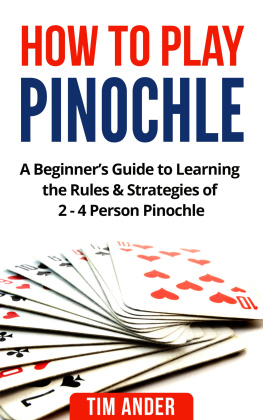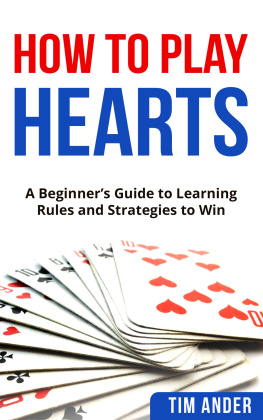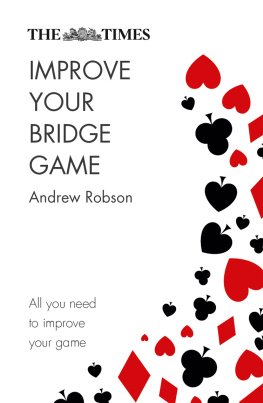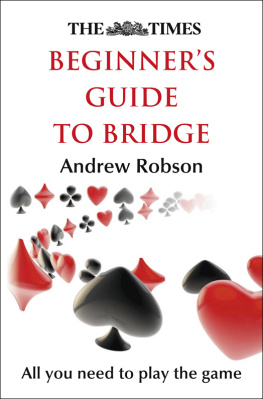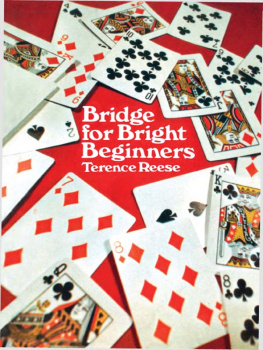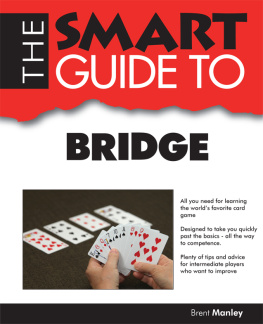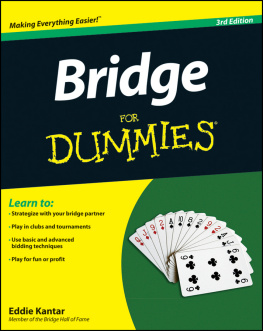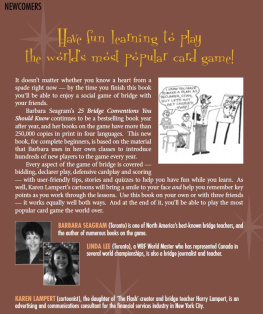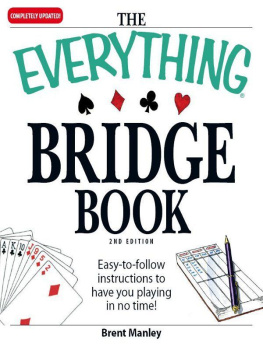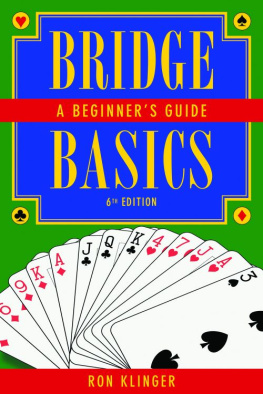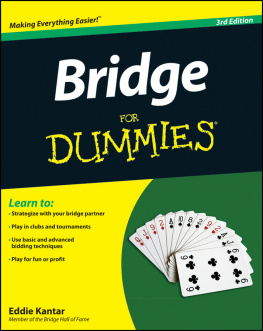TABLE OF CONTENTS
How To Play Bridge
A Beginners Guide to Learning the Game, Bids, Hands, Cards, and Strategies to Win at Bridge
Table of Contents
INTRODUCTION
~
WHAT IS BRIDGE?
BRIDGE, OR CONTRACT BRIDGE TO give it its full name, is a card game involving a standard deck of 52 cards and is played with four players. Players are sat around a table, or anything else which you can play on, and are divided into two partnerships of two, with each partnership competing to score more points than the other.
Bridge is a trick taking game with four phases each time the cards are dealt. Players study their hands and then bid the number of tricks they believe they and their partner will take in the round. Once a bid is made and cannot be bettered, the play begins. The partnership who won the bid will try to gain this number of tricks, while the other partnership will try and defend against this, hoping to take as many tricks as they can.
Scoring is tallied at the end of each round and the winner is declared when a certain number of points is reached, or when certain conditions are met.
HISTORY
The game of Bridge was derived from the game of Whist, which was a popular card game in the 1600s. Much like Bridge, Whist was a game in which four players, playing in partnerships, played to take as many tricks as they could. The main differences to the modern game of Bridge was that there was no bidding to decide which suit would be the trump suit, and there was a different way to score the game.
Whist was very popular in many parts of the world and is still played by many people today. By the late 1800s, the game of Whist was evolving and a number of offshoots were born. A number of betting stake rules were added.
As the world tipped over into the early 20th century, two popular offshoots of the game took hold, Plafond in France and Auction Bridge in other places. Plafond added an extra element in that players would have to announce the number of tricks they would take. Auction Bridge brought the idea of bidding to decide which suit would be the trump suit.
It was in 1925 that these two offshoots of Whist merged to form the game of Bridge which is played worldwide today. It was the American, Harold Vanderbilt, who combined the two while on a long cruise. This combination brought together the unique rules of each game while adding some others to create the game we all know and love today.
A new scoring system was created. The word contract was added to the title to signify the contract which was brokered by the two partners within the game. In the game, the players, who were in partnership together, would be entered into a contract to win the number of tricks decided in the bidding stage. A set of rewards were set up for partners who fulfilled this contract, while there were a set of penalties for those partners who did not.
It was in the early 1930s that Bridge entered the Golden Age. There were many famous matches and tournaments set up. The big game popularity of bridge faded as the 1950s were entered, but the popularity endured.
The ease with which Bridge can be played, along with its complexity, means that Bridge has remained popular over the years. There is also an element of socializing which players love. It is a game where study and luck combined. A game which is cheap to play. The popularity of Bridge, the world over, has continued to this day and by looking at its history, it is clear that it will continue in popularity for a very long time.
HOW TO PLAY
~
THE BASICS
BRIDGE IS PLAYED WITH FOUR players. The players are split into two partnerships of two and partners should sit opposite from each other at the table. Partners can be prearranged, perhaps two couples are playing and wish to stay in their couples, or can be drawn at the beginning of the game. You could draw a card each and the highest card could be paired with the lowest. How the partnerships are decided is entirely up to you.
The game is played with a standard set of cards, where the ace is high and the two is low. In Bridge, all of the suits are ranked equally, except for in the bidding stage, where certain suits rank higher than others, but we will come to that later.
Bridge is split into two main phases, bidding and play. For the purposes of this guide, we will start in reverse order and talk about the play phase first. The bidding phase can be complicated and can put off new and beginner players with its complexity. If we were to delve into the bidding without you knowing how the game is actually played, you would become lost in how to bid and why. By going through the play phase first, you can get an idea of how you should bid, based on your hand and how the game is played.
Bridge is a social game, so go get some drinks and snacks, sit down with your friends and get ready to play.
THE START
To start the game, have the four players seated at the table and choose who will deal first. This can be done by drawing cards, with the highest draw or the lowest draw dealing first. The cards are dealt clockwise around the table, starting with the player to the dealers left. The cards are dealt until they are all gone, giving each player thirteen cards.
You should start by arranging the cards in your hand. Group the cards by suit and then arrange the cards within this suit from low to high (or high to low), from aces to twos. This will help you with the bidding phase and the play phase.
For now, we will skip the bidding phase, which some before the play, and concentrate on the play phase. In the play phase, the goal is to win as many tricks as you can for you and your partner.
When all of the cards have been dealt and the bidding is done, the play phase will begin until all the cards have been played. For the purposes of this guide, we will talk about section of the game, from the deal to all of the cards being played, as the deal.
THE PLAY
The play is where most of the action in the game of Bridge will take place. It is a lot less complicated than the bidding phase and the rules and conventions make it a lot easier to get to grips with as a beginner, though you will see that there is a complexity to it for the more advanced player.
The object in the play phase is to win as many tricks as possible, between your partner and yourself. There are thirteen tricks which can be won after the cards are dealt out, and a trick consists of four cards taken from each of the players, including yourself. This will make more sense as we explore how to play the game.
The first card played is called the lead and is played by the first player. For the first card of the deal, this is decided by the bidding phase. If it is your turn to lead, you can play any card you wish. Simple, right? After a card is led, the next player, clockwise around the table, has some rules to follow. The next player must play a card of the same suit if it is possible. If it is not possible, i.e. they have no cards of the same suit in their hand, then they can play any card they wish. For example, if the lead player plays the 3 of hearts, then all players around the table, one at a time in a clockwise direction, must follow this card with a heart of their own. They can play any rank of heart, but it must be a heart. If they do not have any hearts in their hands then they can play any card they wish. This would be the same is a spade, diamond or club was played.
When all four cards, one from each player, have been played, the highest card wins the trick and the player who played that card scoops up all four cards and places them in a pile by themselves, so that the tricks can easily be counted at the end of the deal. In this way, we can see that thirteen tricks can be won on each deal, this there is a maximum of thirteen tricks possible per deal. The player who wins the trick will lead next until the last four cards are played.


